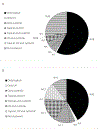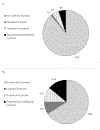A description of treatment patterns of psoriasis by medical providers and disease severity in US women
- PMID: 33738385
- PMCID: PMC7968871
- DOI: 10.1177/2475530320970531
A description of treatment patterns of psoriasis by medical providers and disease severity in US women
Abstract
Background: Studies on treatment patterns of psoriasis are valuable to evaluate how efficiently individuals with psoriasis are treated and may facilitate improved outcomes for these patients.
Objective: To describe treatment patterns of psoriasis among US women.
Methods: In the Nurses' Health Study II (NHS II), a prospective study of female nurses, 2107 women reported to have a diagnosis of psoriasis made by a clinician. We sent them the Psoriasis Screening Tool-2, a validated diagnostic tool for psoriasis, which queries age at diagnosis, treatments, type of psoriasis lesions, body surface area involved, and the provider who made the diagnosis.
Results: A total of 1382 women completed and returned the survey, with 1243 of them validated for having psoriasis. 30% of the patients were diagnosed by non-dermatologists. 79% of the patients reported mild, 17% moderate and 4% severe disease. Psoriasis phenotypes were as follows: plaque 41%, scalp 49%, inverse 27%, nail 22% and palmoplantar 15%. Treatment patterns for mild psoriasis were as follows: only topical treatment 58%, systemic therapy and/or phototherapy 16% and no treatment 26%. Treatment patterns for moderate-to-severe disease were as follows: only topical treatment 42%, systemic therapy and/or phototherapy 47% and no treatment 11%.
Conclusion: The majority of women in NHS II with psoriasis have mild disease. A large proportion of psoriasis patients were diagnosed by non-dermatologists. More than half of people with moderate-to-severe disease received no treatment or only topical medications. A considerable percentage of people with psoriasis reported phenotypes other than chronic plaque psoriasis.
Keywords: biologic; phototherapy; psoriasis; severity; systemic; topical; treatment; treatment pattern.
Conflict of interest statement
Conflict of interest: In the last three years, Dr. Drucker has served as an investigator and has received research funding from Sanofi and Regeneron and has been a consultant for Sanofi, RTI Health Solutions, Eczema Society of Canada and Canadian Agency for Drugs and Technology in Health. He has received honoraria from Prime Inc, Spire Learning, CME Outfitters, Eczema Society of Canada and the Canadian Dermatology Association. His institution has received educational grants from Sanofi and Abbvie. The other authors do not report any recent or relevant disclosures.
Figures



Similar articles
-
Prevalence of psoriasis phenotypes among men and women in the USA.Clin Exp Dermatol. 2016 Jul;41(5):486-9. doi: 10.1111/ced.12805. Epub 2016 Feb 18. Clin Exp Dermatol. 2016. PMID: 26890045 Free PMC article.
-
Psoriasis treatment patterns: results of a cross-sectional survey of dermatologists.J Am Acad Dermatol. 2008 Jun;58(6):964-9. doi: 10.1016/j.jaad.2008.02.048. Epub 2008 Apr 18. J Am Acad Dermatol. 2008. PMID: 18378352
-
Evaluating practice patterns for managing moderate to severe plaque psoriasis: role of the family physician.Can Fam Physician. 2012 Jul;58(7):e390-400. Can Fam Physician. 2012. PMID: 22859642 Free PMC article.
-
Biologics for the primary care physician: Review and treatment of psoriasis.Dis Mon. 2019 Mar;65(3):51-90. doi: 10.1016/j.disamonth.2018.06.001. Epub 2018 Jul 20. Dis Mon. 2019. PMID: 30037762 Review.
-
[Topical corticosteroids and corticosteroid sparing therapy in psoriasis management].Acta Med Croatica. 2007 Sep;61(4):375-81. Acta Med Croatica. 2007. PMID: 18044472 Review. Croatian.
Cited by
-
Endometriosis, Psoriasis, and Psoriatic Arthritis: A Prospective Cohort Study.Am J Epidemiol. 2022 May 20;191(6):1050-1060. doi: 10.1093/aje/kwac009. Am J Epidemiol. 2022. PMID: 35029650 Free PMC article.
-
Patient Disease Characteristics and Treatment Patterns in Mild-Moderate Psoriasis: Results from Real-World Clinical Practice in the United States (PROSPECT Study).Dermatol Ther (Heidelb). 2025 Mar;15(3):663-680. doi: 10.1007/s13555-025-01353-x. Epub 2025 Feb 17. Dermatol Ther (Heidelb). 2025. PMID: 39961971 Free PMC article.
References
-
- Augustin M, Reich K, Glaeske G, et al. Co-morbidity and age-related prevalence of psoriasis: Analysis of health insurance data in Germany. Acta Derm Venereol. 2010; 90:147–51. - PubMed
-
- Ferr_andiz C, Bordas X, Garc_ıa-Patos V, et al. Prevalence of psoriasis in Spain (Epiderma Project: phase I). J Eur Acad Dermatol Venereol. 2001; 15:20–3. - PubMed
-
- Stern RS, Nijsten T, Feldman SR, et al. Psoriasis is common, carries a substantial burden even when not extensive, and is associated with widespread treatment dissatisfaction. J Investig Dermatol Symp Proc. 2004; 9:136–9. - PubMed
-
- Menter A, Gottlieb A, Feldman SR, et al. Guidelines of care for the management of psoriasis and psoriatic arthritis: section 1. Overview of psoriasis and guidelines of care for the treatment of psoriasis with biologics. J Am Acad Dermatol. 2008; 58:826–50. - PubMed
Grants and funding
LinkOut - more resources
Full Text Sources
